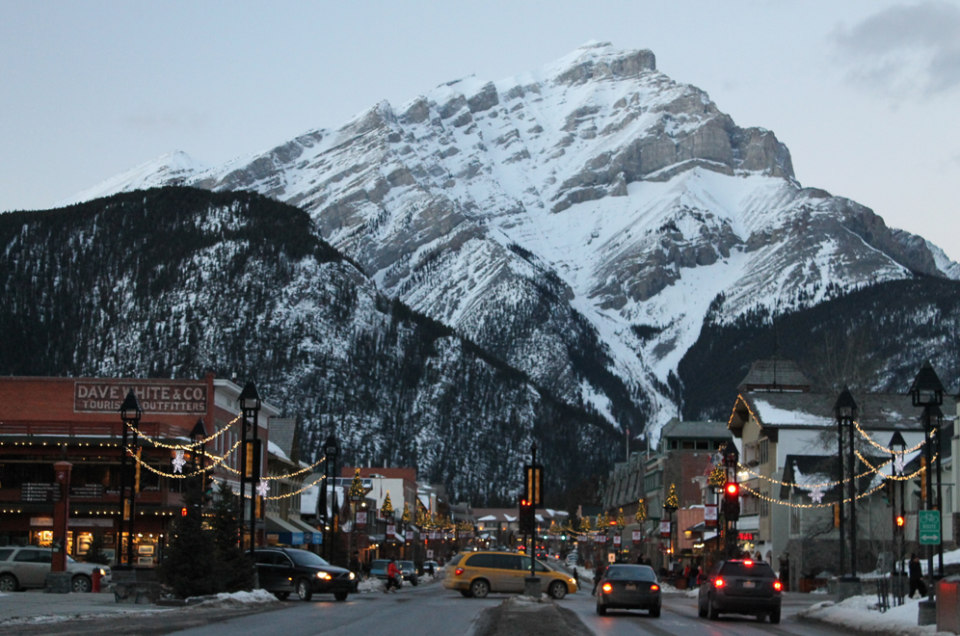One popular Banff bumper sticker reads: “My life is better than your vacation.” Clearly, the resort town’s 7,000 residents relish the spectacular hiking, fishing, and skiing in the Canadian Rockies. Yet Banff has also become a cultural mecca, and the Banff Culture Walk provides a different way to experience this UNESCO World Heritage Site. It’s a self-guided walking tour with 17 suggested stops for culture lovers, featuring hotels, art galleries, museums, and natural marvels. Hoof your way through this sample itinerary, or create your own.
This grand, 768-room hotel in the Scottish baronial style is the ideal starting point, as it originally put Banff on the map. It was built in 1888 by William Cornelius Van Horne, head of the Canadian Pacific Railway, for train travelers seeking repose at the newly discovered hot springs, and was rebuilt after a 1926 fire. Guided tours departing from the Heritage Hall (3 pm, Tues-Sat) include tales of glitterati who’ve stayed here, from music stars like the Guess Who and Benny Goodman to Hollywood VIPs such as Clint Eastwood and Marilyn Monroe.
Whyte Museum of the Canadian Rockies
Named after a Banff couple whose 20th-century paintings immortalized the Rockies, the downtown museum with stone-encrusted walls and skylit halls opened in 1968. Rotating exhibitions include everything from Robert Bateman paintings to the Luxton family’s memorabilia collection with taxidermy specimens, a vintage player piano, and a 1906 guidebook entitled 50 Switzerlands in One: Banff the Beautiful.
Stroll up to this spacious gallery, and you just might start singing “O Canada.” From Peter Shostak’s book Hockey: Under Winter Skies, which depicts kids playing the national sport on frozen backyards, to the soapstone grizzly bears ($250-$3,000) of Ted Griffiths, Canada House celebrates the imagery that defines our country.
“My grandfather, Byron Harmon, was probably the best-known Canadian Rocky Mountain photographer of the early 20th century,” says proprietor Carole Harmon. The family tradition continues at this elegant store, from Byron’s B&W shots of the Columbia Icefield to Carole’s sensitive close-ups of wildflowers.
Up to 100,000 visitors flock to this National Historic Site annually. The handsome, Douglas fir-paneled historic house has operated as a museum since 1903, and its Victorian nature dioramas still resonate with intrigue. Must-sees include bighorn sheep perched in diverse terrain, a bison leg bizarrely wedged in a log, and a red-breasted merganser from 1860, the oldest specimen on display.
Resembling a log stockade, this venue is easy to spot, just across the Bow River from downtown. Inside, you’ll find a superb collection of artifacts from the First Nations of North America, such as the Blackfoot, Kootenay, and Ojibway. The secrets of bear-hunting and pemmican-making are revealed alongside dog sleds and teepees. The museum, conceived by local entrepreneur Norman Luxton, was completed in 1961.
Cave and Basin National Historic Site
A 15-minute walk from Buffalo Nations, here’s where Canada’s national parks system was born in 1885 when railway workers discovered thermal hot springs. The pungent scent of sulphur lingers inside an Indiana Jones-like cavern. Outdoors, view tiny snails in warm pools–they’re an endangered species unique to Banff. Exhibits show how the national railway affected the parks system (“Since we can’t export the scenery, we’ll import the tourists” – William Cornelius Van Horne, 1885), and also tout the future goal of protecting 12 percent of Canada’s wilderness.
For over 75 years, the Banff Centre has fostered the careers of internationally successful artists. The Walter Phillips Gallery showcases cutting-edge, contemporary paintings, sculpture, textiles, photography, and new media year-round (Wed-Sun).
